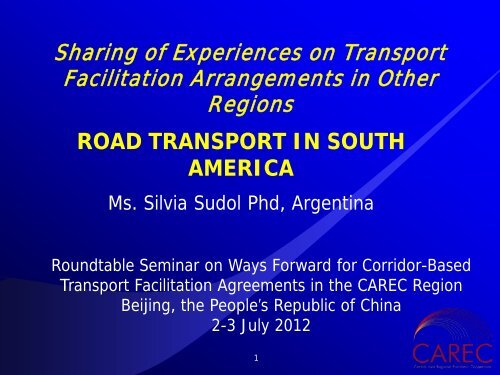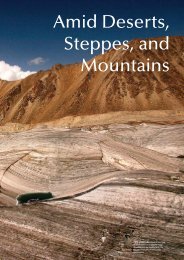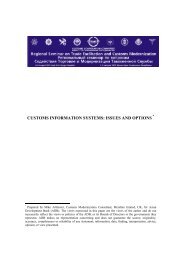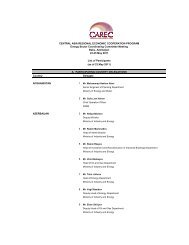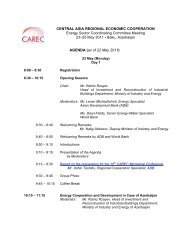Road Transport in South America - CAREC
Road Transport in South America - CAREC
Road Transport in South America - CAREC
Create successful ePaper yourself
Turn your PDF publications into a flip-book with our unique Google optimized e-Paper software.
Shar<strong>in</strong>g of Experiences on <strong>Transport</strong><br />
Facilitation Arrangements <strong>in</strong> Other<br />
Regions<br />
ROAD TRANSPORT IN SOUTH<br />
AMERICA<br />
Ms. Silvia Sudol Phd, Argent<strong>in</strong>a<br />
Roundtable Sem<strong>in</strong>ar on Ways Forward for Corridor-Based<br />
<strong>Transport</strong> Facilitation Agreements <strong>in</strong> the <strong>CAREC</strong> Region<br />
Beij<strong>in</strong>g, the People’s Republic of Ch<strong>in</strong>a<br />
2-3 July 2012<br />
1
Introduction<br />
<strong>Transport</strong> plays a key role <strong>in</strong> the construction and<br />
development of regional <strong>in</strong>tegration processes<br />
through:<br />
§ efficient transport corridors<br />
§ agile movement of goods and people accross<br />
borders<br />
§ development of dynamic and safe transport with<br />
adequate <strong>in</strong>frastructure systems<br />
<strong>South</strong> <strong>America</strong> is an area with actors that share<br />
much history but simultaneously are different from<br />
each other.<br />
2
Evolution and History<br />
Land transport <strong>in</strong> Lat<strong>in</strong> <strong>America</strong>’s <strong>South</strong>ern Cone:<br />
§ Present truck<strong>in</strong>g transport <strong>in</strong> <strong>South</strong> <strong>America</strong> is the result<br />
of long processes to reach agreements between<br />
parties.<br />
1950s−1960s:<br />
§ Standards of trade facilitation were improved, and a<br />
system of legal transit of vehicles beyond borders was<br />
developed.<br />
§ Transit between Argent<strong>in</strong>a and Brazil was followed by<br />
the development of road transport <strong>in</strong> all of Lat<strong>in</strong><br />
<strong>America</strong>’s <strong>South</strong>ern Cone (Arg, Bra, Chi, Par, Uru).<br />
§ International transit from Brazil to Uruguay <strong>in</strong> 1963 and<br />
to Argent<strong>in</strong>a <strong>in</strong> 1964 was made possible.<br />
3
1950s−1960s:<br />
§ 1965: II National Congress of Land <strong>Transport</strong> <strong>in</strong> São<br />
Paulo (Brazil).<br />
§ 1966: Convention on International Land <strong>Transport</strong><br />
between Argent<strong>in</strong>a, Brazil and Uruguay.<br />
1970s−1980s:<br />
Evolution and History<br />
§ 1977: (Mar del Plata, Argent<strong>in</strong>a), Convention of<br />
International Land <strong>Transport</strong>.<br />
§ 1989: The International Land <strong>Transport</strong> Agreement was<br />
signed between Argent<strong>in</strong>a, Bolivia, Brazil,<br />
Chile,Paraguay, Peru, Uruguay.<br />
4
Highlights:<br />
Evolution and History<br />
§Dur<strong>in</strong>g the 1950s−1970s, <strong>in</strong>ternational trade <strong>in</strong>creased by<br />
130%.<br />
§An <strong>in</strong>stitutional framework aligned to the regional situation<br />
was essential.<br />
§International trade was deepened <strong>in</strong> the 1990s with<br />
Brazil's most important regional trade <strong>in</strong>itiative - the<br />
Common Market of the <strong>South</strong>.<br />
5
Lat<strong>in</strong> <strong>America</strong> - <strong>South</strong> Cone<br />
6
Brief description of the coverage of<br />
facilitation measures<br />
Instrument: Agreement of International Land<br />
<strong>Transport</strong> (ATIT)<br />
§ Signed <strong>in</strong> Santiago, Chile, <strong>in</strong> September 1989.<br />
§ “International transport” means land transportation<br />
with:<br />
1) bilateral traffic across border; the traffic<br />
between 2 neighbour<strong>in</strong>g signatory countries<br />
2) bilateral traffic, with transit through third<br />
countries, and<br />
3) traffic <strong>in</strong> transit to non-signatory countries<br />
7
ATIT<br />
Reciprocity is the central aspect of the ATIT<br />
§Prohibits cabotage (local transport) among the signatory<br />
countries.<br />
§Consists of 3 annexes, besides the ma<strong>in</strong> “body”, 1)<br />
"Customs matters"; 2) "Immigration matters" and 3) "Aspect<br />
of Insurance," and with a "Regime of Infr<strong>in</strong>gements and<br />
Sanctions", called "Annex 4.“<br />
§The transport of dangerous goods has its own regime, <strong>in</strong> a<br />
separate Agreement reached among the MERCOSUR<br />
countries, based on the rules of the United Nations <strong>in</strong> this<br />
respect.<br />
§Article 16 establishes the possibility of reform<strong>in</strong>g or<br />
updat<strong>in</strong>g the Agreement, at the request of either party.<br />
8
ATIT<br />
§Implementat<strong>in</strong>g Agencies : In Argent<strong>in</strong>a is the<br />
Undersecretariat of <strong>Road</strong> <strong>Transport</strong>, and <strong>in</strong> all other<br />
countries, it is the M<strong>in</strong>istry of <strong>Transport</strong>.<br />
qBasic aspects established by the Agreement:<br />
§Taxes established <strong>in</strong> every country must be respected<br />
(art. 9)<br />
1) The documents which authorize to drive<br />
vehicles issued by a signatory country to drivers <strong>in</strong>volved <strong>in</strong><br />
traffic governed by this Agreement, have to be recognized<br />
as valid by the other signatory countries, without any<br />
restriction.<br />
9
ATIT<br />
§(art.18) A signatory country must <strong>in</strong>form the other<br />
national bodies’ authorities before it takes and enforces<br />
measures that will affect <strong>in</strong>ternational land transport.<br />
Fundamental def<strong>in</strong>itions that establishes the ATIT<br />
§Permits:<br />
1) Orig<strong>in</strong>al Permits<br />
2) Additional Permits<br />
§Articles 22−24<br />
§Bil<strong>in</strong>gual Suitability Document<br />
§Legal representative<br />
§The truck company should hold an <strong>in</strong>ternational<br />
10
ATIT<br />
- Transit Permit : The company has to present the Orig<strong>in</strong>al<br />
Permit to the Applicable National Agency of the country<br />
where the vehicles are go<strong>in</strong>g to transit.<br />
§Force : (art. 25)<br />
§180-day deadl<strong>in</strong>e to grant permits; provisional permits<br />
may be granted <strong>in</strong> case of delays.<br />
§Each country’s transport authority decides on permits,<br />
harmonization is not yet achieved.<br />
§Required documentation such as Letter from International<br />
Carriage.<br />
§Compla<strong>in</strong>ts, sanctions, penalties: (art. 34).<br />
§Procedure for grant<strong>in</strong>g Occasional Permits for cargo<br />
transported by road<br />
11
MERCOSUR<br />
§ <strong>Road</strong> <strong>Transport</strong> <strong>in</strong> the Common Market of the <strong>South</strong>:<br />
(MERCOSUR): Argent<strong>in</strong>a, Brazil, Paraguay, Uruguay.<br />
§ The ma<strong>in</strong> negotiation basis adopted among the countries<br />
of the MERCOSUR is the ATIT.<br />
§ Harmonization of transport <strong>in</strong> MERCOSUR is the ma<strong>in</strong><br />
objective.<br />
- The Subgroup Nr. 5 “<strong>Transport</strong>” depends on the<br />
structure (as other Subgroups) of the MERCOSUR<br />
common market Group (GMC), and on the Summit of<br />
Presidents of the Council of the Common Market.<br />
12
MERCOSUR<br />
§Discussion of issues on several topics are held by the<br />
Subgroup Nr. 5.<br />
§Weights and dimensions of vehicles – height of vehicles<br />
for <strong>in</strong>ternational transport was raised.<br />
§Conditions for access to the professional activity –<br />
requirement of 80 tons of dynamic capacity of<br />
transportation.<br />
§A permanent agenda of the subgroup analysis is<br />
"facilitation or national borders speed<strong>in</strong>g up".<br />
13
Lessons - Advice to <strong>CAREC</strong><br />
1) “Spirit of the Law” of the Agreements is frecuently<br />
broken down and agreements may fail because of this.<br />
2) Allow flexible transit throughout pend<strong>in</strong>g <strong>in</strong>frastructure<br />
works.<br />
3) Simplify the rules.<br />
4) Streaml<strong>in</strong>e computer systems and on-l<strong>in</strong>e facilities.<br />
5) Learn from the modern system called Authorized<br />
Economic Operator.(WCO)<br />
6) Apply risk management techniques, designed to ensure<br />
targeted <strong>in</strong>tervention.<br />
14
Lessons - Advice to <strong>CAREC</strong><br />
7) Be guided by the Safe Framework def<strong>in</strong>ed by<br />
collaboration between Customs adm<strong>in</strong>istrations and<br />
partnership between Customs and the private sector.<br />
8) Coord<strong>in</strong>ated Border Management and the “s<strong>in</strong>gle<br />
w<strong>in</strong>dow concept” as models. (WCO)<br />
9) Study the TIR system which could help with long delays<br />
and solve problem of warrants <strong>in</strong> case of theft. (E.U)<br />
10) Solve the problem on the lack of statistics or unreliable<br />
statistical data.<br />
11) Build <strong>in</strong>stitutional capacities.<br />
12) Grant <strong>in</strong>-transit status rather than tourist-status to<br />
drivers.<br />
15
Lessons - Advice to <strong>CAREC</strong><br />
13) Involve the private sector.<br />
14) Follow-up decisions reached <strong>in</strong> consensus.<br />
15) Th<strong>in</strong>k of <strong>in</strong>termodal transport systems.<br />
16) Optimize fund<strong>in</strong>g of projects to borders-cross<strong>in</strong>g.<br />
17) Plan how to address <strong>in</strong>cidences of theft and cases of<br />
smuggl<strong>in</strong>g.<br />
18) Prioritize road safety.<br />
16
Conclusions<br />
§ <strong>Transport</strong> plays a key role <strong>in</strong> the construction and<br />
development of regional <strong>in</strong>tegration<br />
§ Facilitation <strong>in</strong>struments are necessary, but it is a long<br />
and evolutionary process<br />
§ Lat<strong>in</strong> <strong>America</strong> has grown over the past years at very<br />
high rates and also <strong>in</strong>tra-regional trade. Without the<br />
ATIT this would not have been possible.<br />
§ Long-term development policies, through provision of<br />
adecuate <strong>in</strong>frastructure and efficient transport<br />
services, are crucial to improve productivity and<br />
competitiveness.<br />
17
Border Cross<strong>in</strong>gs Photos<br />
INTERNATIONAL GOODS<br />
TRANSPORT BY ROAD – SOUTH<br />
CONE
PASO DE LOS LIBRES (AR) – URUGUAYANA (BR)
PASO INTERNACIONAL CRISTO REDENTOR (AR) – LOS<br />
LIBERTADORES (CH)


